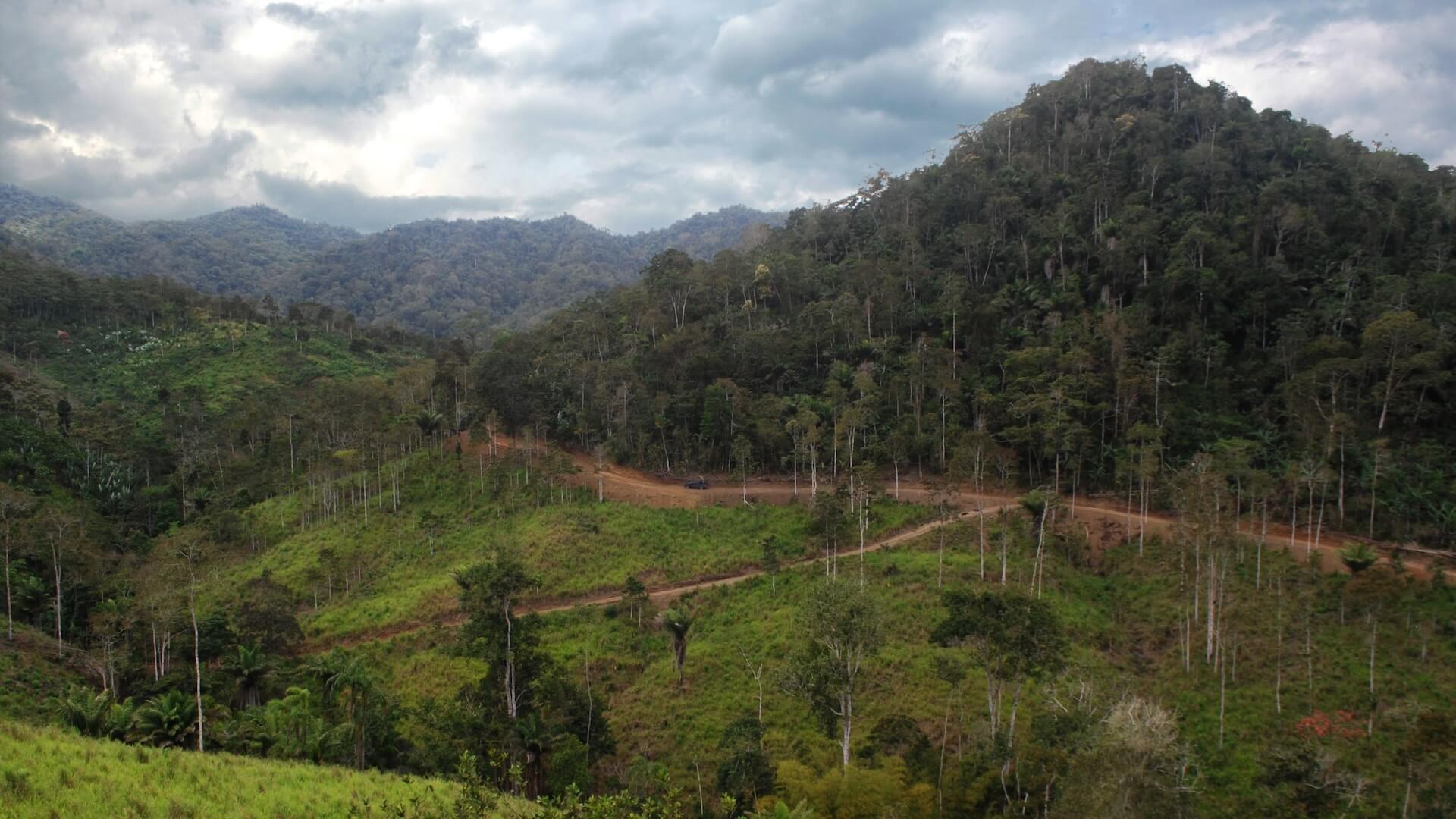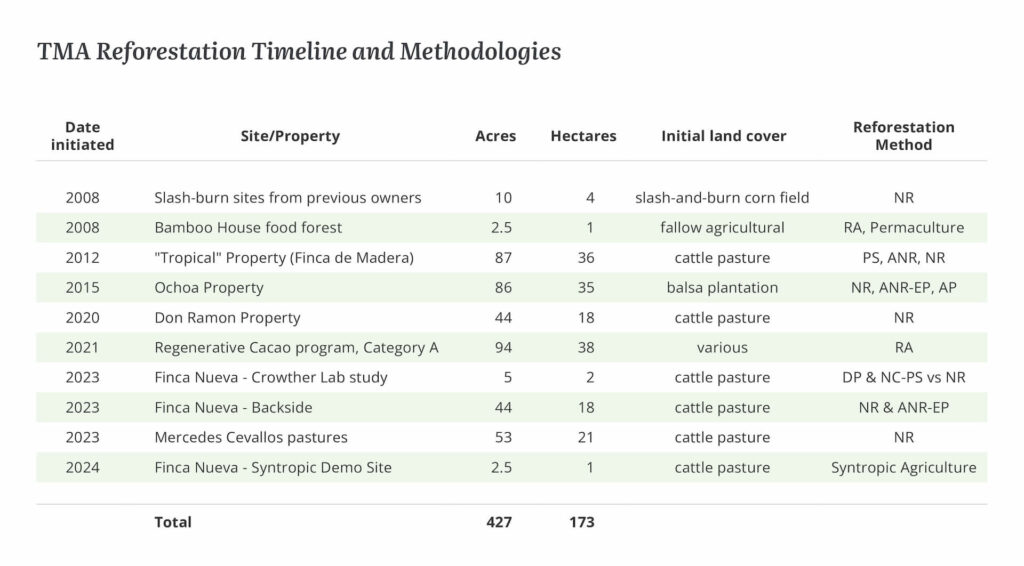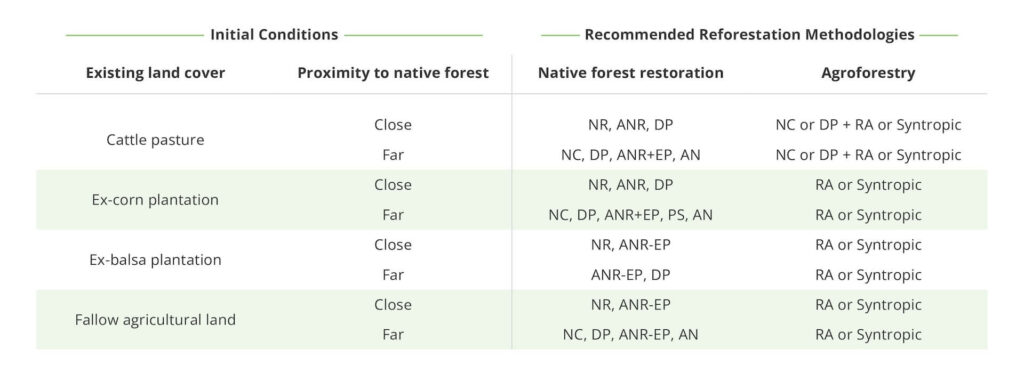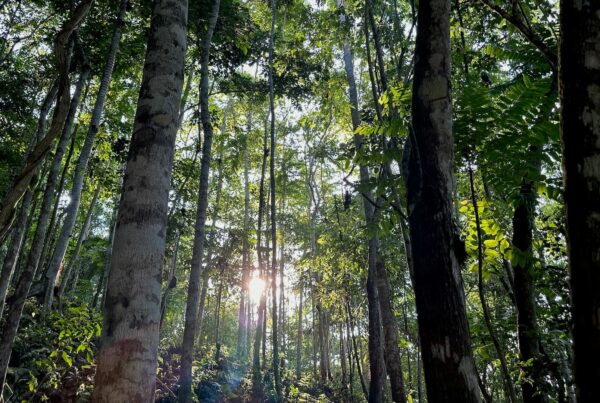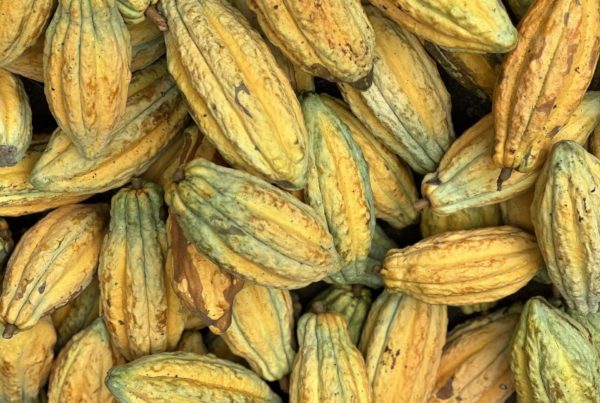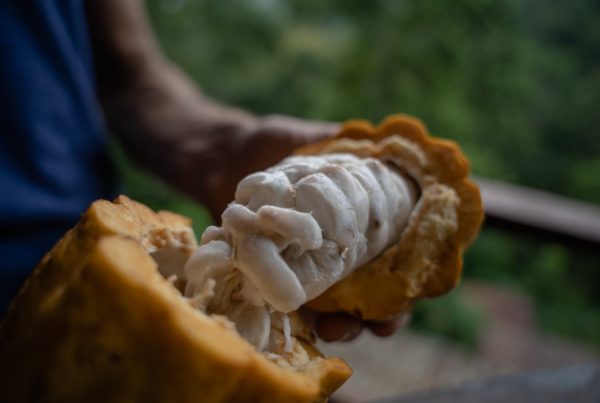The key to reforestation is not planting trees
In 2012, we were given the opportunity to reforest 87 acres of cattle pasture. Today, that property is densely forested with a canopy height over 50 feet tall—and growing taller every year. But it didn’t quite happen the way we expected. Our initial approach was flawed.
A few years later, we were tasked with reforesting a 188-acre property that had recently been clear-cut to harvest balsa. Again, we got a similar result: the forest rapidly recovered, but in a way that surprised us.
Thus began a sequence of reforestation projects in coastal Ecuador that fundamentally transformed our understanding of what it means to reforest land.
At the core of this understanding is nature’s ability to heal itself. The corollary to this understanding is the revelation that planting trees is not the key to reforestation—especially when it comes to cattle pasture, which is notoriously challenging.
It took us about 20,000 seedlings, and a few seasons of slopping around in the mud, to learn that lesson. We were making the same mistake that many token reforestation projects do—which is to attack the problem the way your average military general approached warfare in the 19th century, in which soldiers blindly march into the direct fire of the opposing army.
The trick is to let Mother Nature drive the process. Deforested land wants to be forest. All it needs are the right conditions for recovery. That is the secret to the whole thing.
Thus far, we’ve reforested over 427 acres across ten different reforestation projects over the course of 15 years in coastal Ecuador. By “we”, I mean a group of people plus Mother Nature. Below are some of the most important lessons we’ve learned throughout that process.
- After-care is more important than planting.
- Methodology is determined by initial conditions.
- Mother Nature is better at planting trees than humans are.
- Harness the power of natural forest succession.
- Think about what to subtract before thinking about what to add.
- Weeds are your best friend.
- Your friendship with weeds is conditional.
- ANR is the best bang for your buck.
- Apply the principles of judo to reforestation.
As a companion piece to this article, you can also refer to our reforestation guide, which provides a brief explanation of all eleven different reforestation methodologies we’ve experimented with since 2008.
Note: this article primarily discusses native forest restoration. For more about our extensive work in regenerative agroforestry, check out Smithsonian Magazine’s feature article about our regenerative cacao project (“The Quest to Save the World’s Most Coveted Chocolate“) our own article on the same subject (“How TMA and To’ak are Using Chocolate to Restore the Rainforest“).
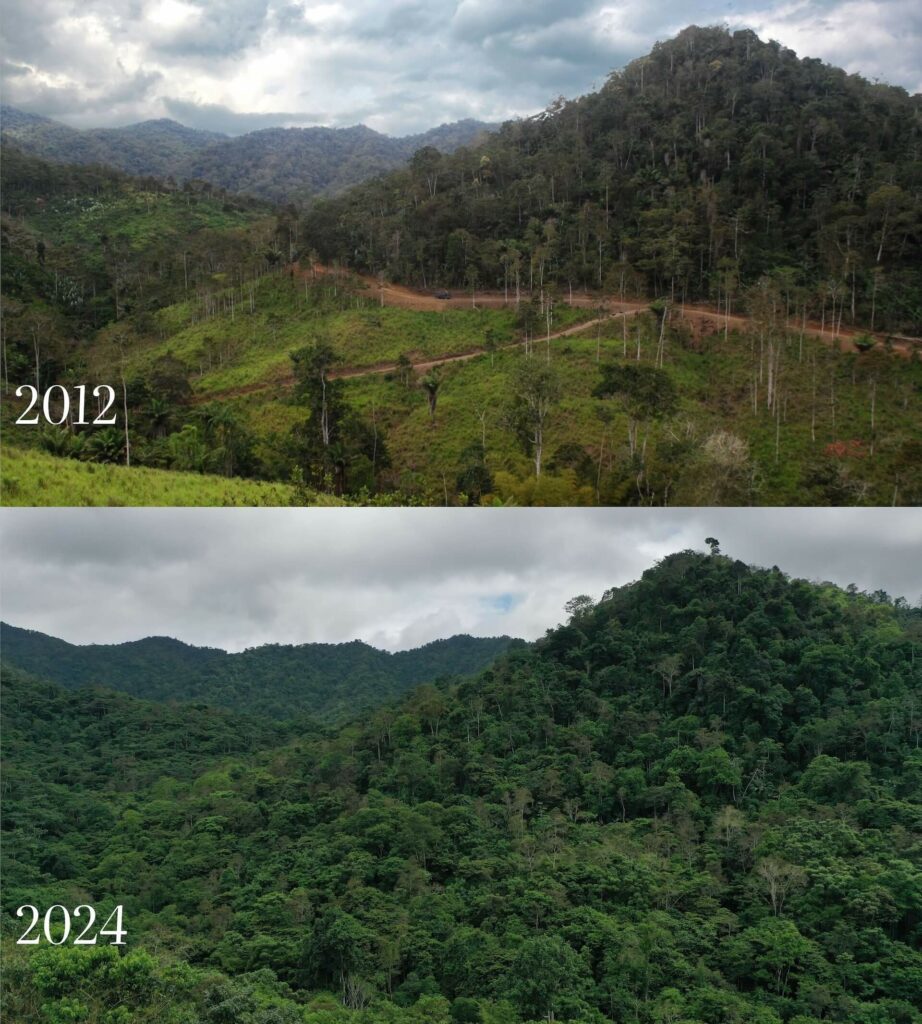
The “A Block” of the 87-acre cattle pasture property before planting vs today. (Finca de Madera)
Lesson #1: After-care is more important than planting
After-care is not only an important part of love-making and psychedelic therapy. It’s also a critically important feature of any reforestation project. Unfortunately, it’s also the feature that is most often ignored or underestimated.
In the grand scheme of most forest restoration projects, planting trees is only a small part of the work that needs to be done. In most cases, planting is merely one of the first steps in a multi-year process of caring for the trees until they can fend for themselves.
Underestimating the importance of after-care is one of the biggest problems with some of the feel-good tree-planting programs associated with retail carbon offset platforms or corporate sponsorships. It’s easy to pop a seed or even a seedling, into the ground. If that’s all you do, you’ve done almost nothing. The real questions are: what did you do to prepare the land ahead of time, and what are you doing to care for the plant for the next three to five years? If you don’t have a strong answer to those two questions, don’t even bother putting anything into the ground—it will just be a waste of everyone’s time and of someone’s money.
Lesson #2: Methodology is determined by initial conditions
The most important tactical decisions of a reforestation project are driven by the conditions of the land at the starting point. Pre-planting, planting, and post-planting protocols will vary based on the type of land you’re working with.
The key variables are slope, climate, soil, existing vegetation, and proximity to native forest. The latter two variables are probably the most important. Cattle pasture, an old corn field, fallow scrubby land, or a recently harvested balsa plantation all call for different approaches. Their proximity to native forest adds another layer to the equation.
For example, the worst way to reforest a cattle pasture is to actively plant trees in the first year. As a baby seedling planted into a cattle pasture, your task is to outcompete an invasive pasture grass on compacted soil while nakedly exposed to the sun. It’s not a fair fight.
The only way to keep those seedlings alive in the first year is through a tremendous infusion of labor—namely, the constant and seemingly futile efforts at manually weeding pasture grass, mulching, and possibly hand-watering individual seedlings. The labor investment is needlessly high, and the survival rates will still probably be low. Especially at larger scales, it’s not worth it.
We learned this lesson the hard way.
When it comes to cattle pasture, it’s far more efficient and effective to use methodologies such as Assisted Natural Regeneration (ANR), Nurse Cropping (NC), Delayed Planting (DP), and/or Applied Nucleation (AN), depending on the land’s proximity to native forest.
Below is a glossary of terms followed by a methodology recommendation matrix based on reforestation conditions that we’ve worked in. Definitions of each term can be found in our Brief Summary of Reforestation Methodologies.
- natural regeneration (NR)
- assisted natural regeneration (ANR)
- enrichment planting (ER)
- plantation-style reforestation (PS)
- delayed planting (DP)
- nurse cropping (NC)
- applied nucleation (AN)
- farmer managed natural restoration (FMNR)
- permaculture
- regenerative agroforestry (RA)
- syntropic agroforestry
Lesson #3: Mother Nature is better at planting trees than humans are
During the first years of our project to reforest the cattle pasture, we mistakenly believed that the return of the forest depended on the seedlings we planted. In truth, the seedlings helped. But they were only part of the story.
In Year 1, we planted many thousands of trees, plantation-style, at a density of 3m x 3m. As expected, about half of these died in the harsh conditions of a sun-scorched pasture of elephant grass during the first year.
In Year 2, we planted more trees—filling in all the gaps left from Year 1. The following year, we planted still more trees. Slowly but surely, they gained a foothold.
By the end of Year 3, the trees we planted were finally healthy and growing taller by the month, which was exciting to watch. But what was more interesting to see is that they weren’t alone. Suddenly they were joined by thousands and thousands of other trees that we didn’t plant.
By Year 5, it was apparent that the project would be a runaway success. The cattle pasture was entirely replaced by an early successional forest. Roughly ten years after the first trees were planted, the canopy is already over 50 feet tall.
The speed of this recovery surprised everyone. Just as surprising was the composition of the trees that were growing. Even in the section that was actively planted with native timber trees, only half of the trees currently growing were planted by humans. The other half of the trees were planted by birds and other animals.
Land that was once forest never ceases to be forest in the fabric of its being. The seed of its true nature is always sitting just below the surface, waiting for the right conditions in which to germinate. Our role, as humans, is to create those conditions. The forest itself will do the rest.
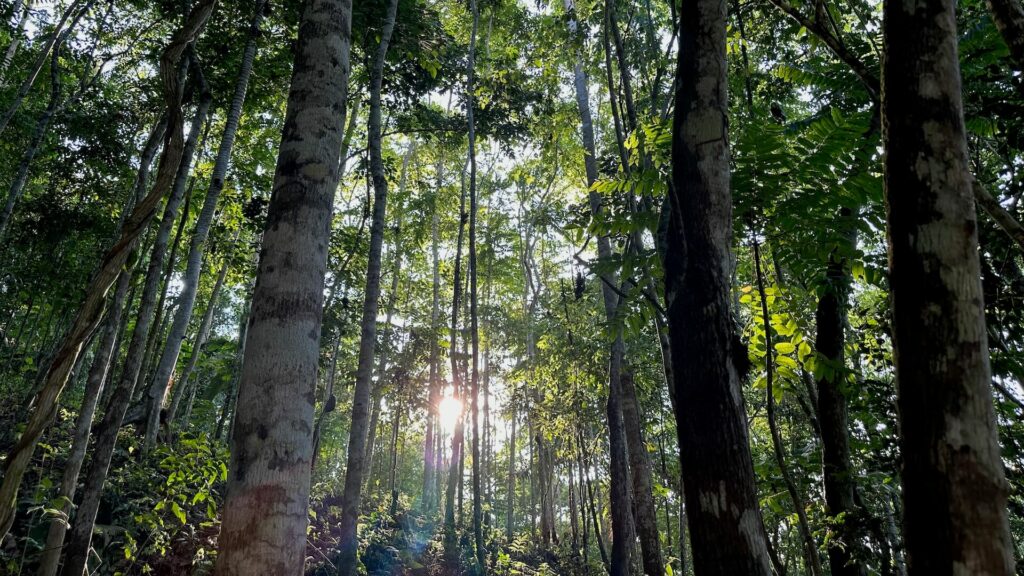
View inside the “Finca de Madera” property 12 years after initial planting into the cattle pasture.
Lesson #4: Harness the power of natural forest succession
When I refer to “Mother Nature” in the previous section, I’m not referring to something supernatural. I’m referring to the scientific process known as ecological succession—also called natural forest succession.
This is the ecological process by which the structure and composition of a forest change in a somewhat predictable manner as time progresses. This process occurs as different species of plants and animals colonize and alter the environment, making it more suitable for other species to follow. This creates a “succession” of species, which tends toward bigger trees and greater diversity over time.
With the exception of very badly degraded areas, this process will proceed on its own without any human intervention. Indeed, removing human intervention is often the only action required to trigger natural forest succession.
For this reason, natural forest succession is usually the star of the show. It is an indomitable force of nature and the real engine of any forest restoration project. All we can do, as humans, is coax this process along, make sure nothing is impeding it, and occasionally accelerate or even redirect it. Methods to accelerate the process include assisted natural acceleration (ANR), enrichment planting (EP), applied nucleation (AN), and nurse cropping (NC). Methods to redirect the process include syntropic agriculture and permaculture.
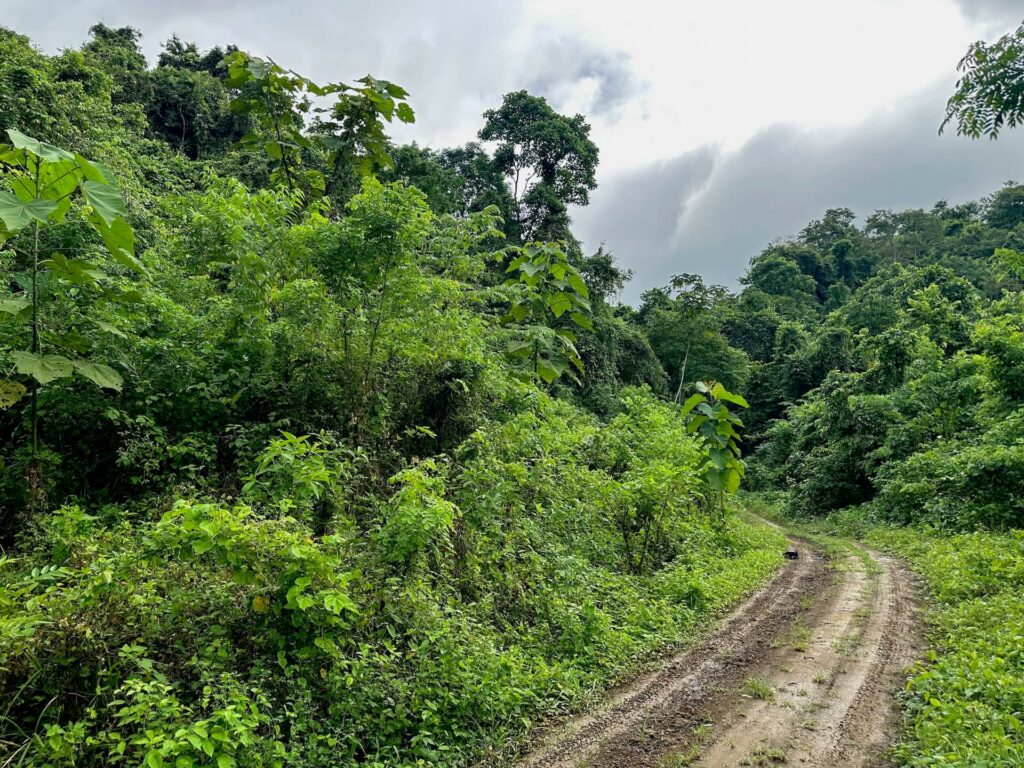
The left side of this road was excavated and mined for gravel to build another road in 2018. All soil was stripped, leaving nothing but rock. Six years later, the forest is already coming back – with zero help from humans. This is a testament to the power of natural forest succession and the tenacity of early-successional pioneer species. All of that vegetation is literally growing in rocks.
Lesson #5: Think about what to subtract before thinking about what to add
Like most of the tropical lowlands of Latin America, the Pacific Forest of Ecuador was once entirely forested. The natural “steady state” of this land is forest. That’s what the land wants to be.
The land only becomes a cattle pasture when humans slash and burn the native vegetation, plant grass, and introduce cattle onto the scene. From that point on, the humans and the cattle continually work together to actively repress the resurgence of the native vegetation in favor of the grass.
This is a key lesson that we learned through experience. At the outset of any forest restoration project, before you think about what needs to be added to the land, the first order of business is to think about what needs to be subtracted. In other words, if you remove the barriers to natural forest succession, in most cases Mother Nature will take care of the rest.
The main barriers to natural succession are:
- cattle
- cyclical slash-and-burn activities by humans
- other extractive activities like logging
- more generally, machetes and chainsaws
- invasive species
- chemical pesticides and herbicides and synthetic fertilizers
- lack of biodiversity (i.e., lack of natural seed dispersers)
Likewise, the most important actions to encourage forest recovery are:
- Remove cattle
- Stop slashing and burning
- Stop logging—or, at the very least, only log selectively
- Remove invasive species, if necessary or possible
- Stop using synthetic pesticides, herbicides, and fertilizers
- Stop hunting and/or eliminating habitat for wildlife (especially seed dispersers)
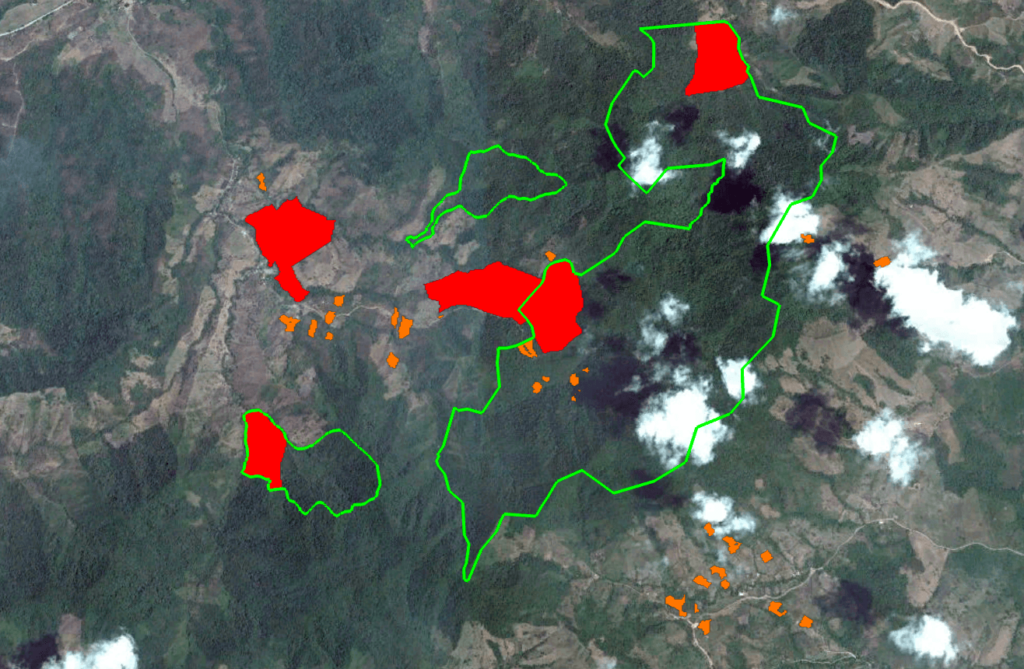
Map of TMA reforestation projects. The Jama-Coaque Reserve is outlined in green; native forest restoration projects are in red; regenerative agroforestry parcels are in orange.
Lesson #6: “Weeds” are your best friend
I put “weeds” in quotes because it’s a derogatory term for an extremely important element of any ecosystem and a crucial tool in forest restoration. So-called “weeds” are merely the first wave of native vegetation that help initiate the process of natural forest succession.
There is a tendency among gardeners to view weeds as enemies. To reforestation practitioners, weeds are your best friend—at the very least, for the first few years.
The initial condition of a cattle pasture is a sea of elephant grass, owing to the efforts of humans and cattle. As soon as the humans and cattle are removed from the land, the “weeds” (i.e., native vegetation) fight back. The elephant grass can maintain dominance for the first year, but by the second year, the native vegetation begins to naturally appear. Natural forest succession has begun.
By the third year, the native vegetation continues to surge, as shrubs and pioneer trees multiply and then suddenly exceed the height of the elephant grass—thus starting to shade it out. The elephant grass is still present at this point, but its fate is sealed.
Once the native vegetation begins to block out the sun, the elephant grass recedes. By the fourth year, the battle is over. Natural succession has firmly taken control of the land. At this stage, the recovery of the forest continues by force of inertia—in much the same way that a ball rolls downhill. The only thing that can stop it is fire, humans, or ruminants.
In this scenario, the “weeds” have naturally achieved something that would have required a massive investment in human labor to achieve—namely, stifling the growth of elephant grass.
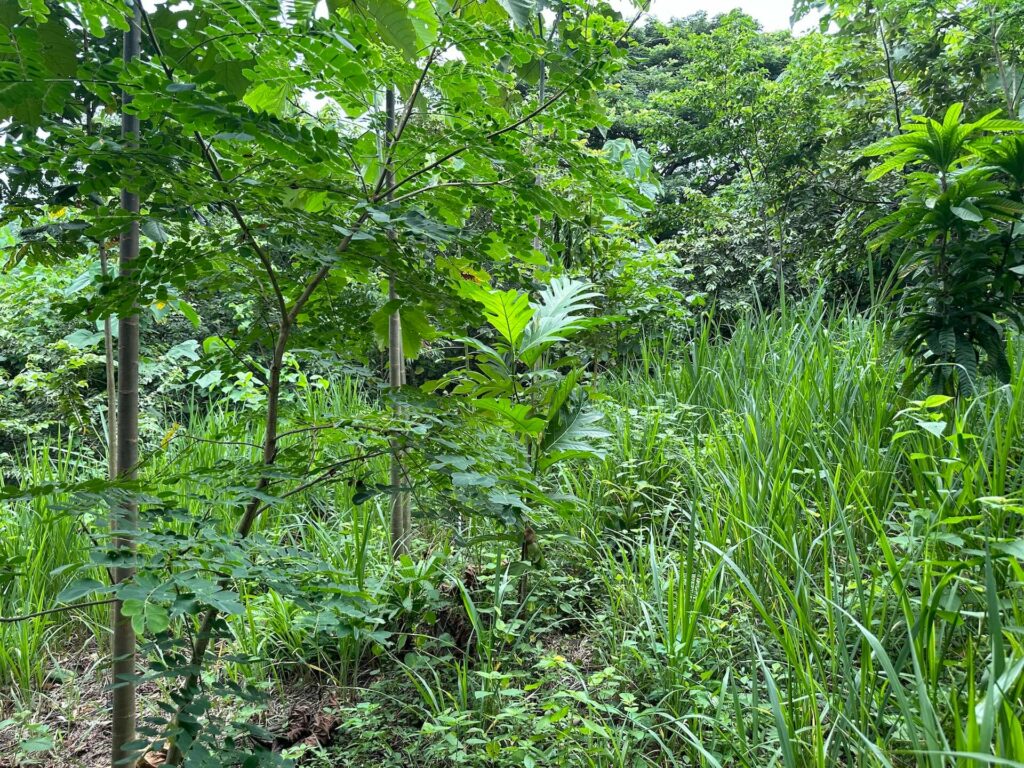
Nurse trees and pioneers (left) beginning to shade out elephant grass (right). Photo from the Crowther Study site in the Jama-Coaque Reserve.
Lesson #7: Your friendship with weeds is conditional
Natural forest succession is a long-term process that unfolds over the course of a century or more, but the initial years are arguably the most important.
A key catalyst of this process is what ecologists call “volunteer trees,” which appear during the first few years of regrowth. To the untrained eye, they may look like “weeds.” In fact, many of them are weeds. But some of them are trees, and you need them.
Volunteers are native trees (or shrubs) that sprout and grow naturally without being deliberately planted by people. They typically emerge from seeds that are dispersed by animals, wind, water, or other natural means.
Some of these volunteer trees are “early successional” species that specialize in colonizing degraded or deforested areas. Another term for early successional species is “pioneer species.” Typically, they are hardy trees that are adapted to survive in difficult conditions, grow quickly, and die young.
But some of these volunteer trees may be “mid-successional” or even “late-successional” species. Meaning that they are trees that will grow tall, form the canopy of the forest, and potentially live many decades if not centuries.
As you walk through an early successional forest, be on the lookout for seedlings or saplings of desirable species that have naturally sprouted. Once you find them, your next move is to give them a helping hand. The main way to do this is to selectively remove any other vegetation that may compete with them for sunlight, water, and nutrients. In other words, chop and drop the weeds that surround the desirable volunteers.
That is the basis for the method known as Assisted Natural Regeneration (ANR), which is among the most cost-effective approaches to reforestation.
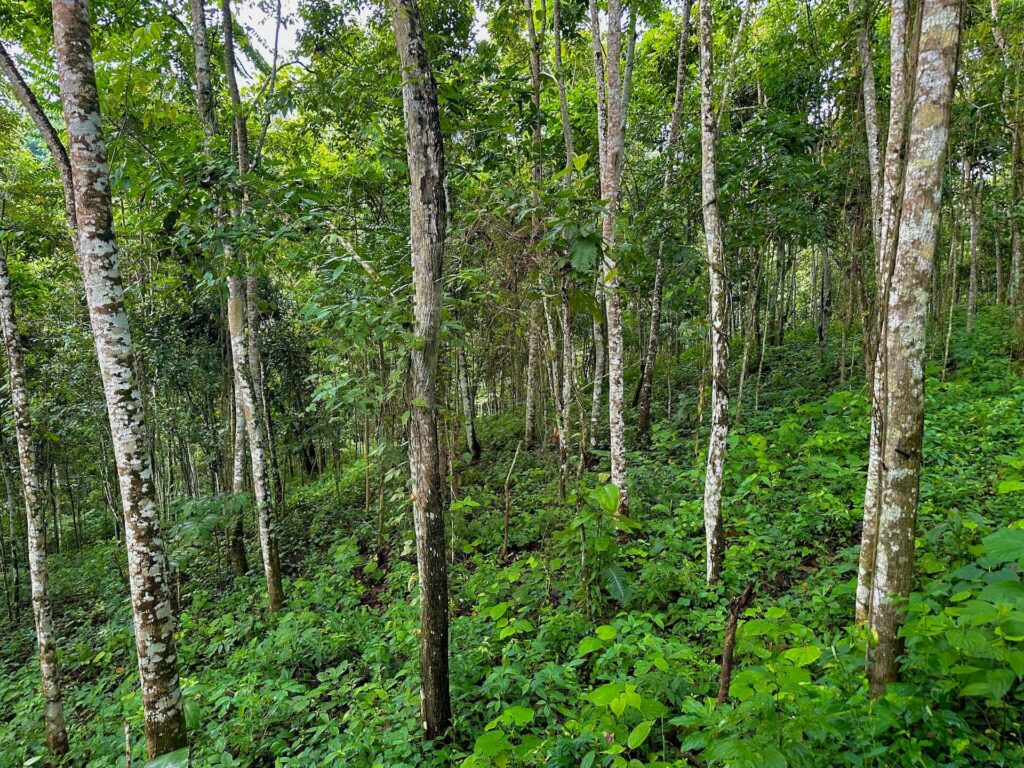
ANR in action: selective removal of weeds at the base of desired trees. (Finca de Madera)
Lesson #8: ANR is the best bang for your buck
There are several benefits of ANR compared to conventional tree-planting and other approaches to reforestation.
First and foremost, ANR is much more cost-effective than other reforestation methods because it relies heavily on natural processes and requires fewer inputs like nursery-raised seedlings and labor. Nature does the heavy lifting—humans just support the process.
The other benefit of ANR is that it encourages the growth of native species that are already adapted to local conditions, which tend to have higher survival rates than nursery-raised seedlings. Even if a nursery-raised seedling is native to the broader region, it may still have difficulty adapting to the microclimate and soil conditions of the specific river valley that you’re working to restore.
Moreover, trees raised in a nursery are often not as hardy as volunteer trees that naturally sprout on-site. Some nursery-raised seedlings suffer transplant shock when planted into the field. Other nursery-raised seedlings may have spent too much time in the nursery, such that their taproot gets deformed at the bottom of the grow bag.
There are two caveats to ANR. If you’re working with highly degraded land that is far from patches of existing forest, you will probably need to actively plant trees. This could come in the form of enrichment planting (EP), nurse cropping (NC), or even plantation-style (PS) planting.
The other caveat is that ANR only applies if your objective is the restoration of native forest. If your objective is a native timber plantation or agroforestry production, other methodologies will be needed.
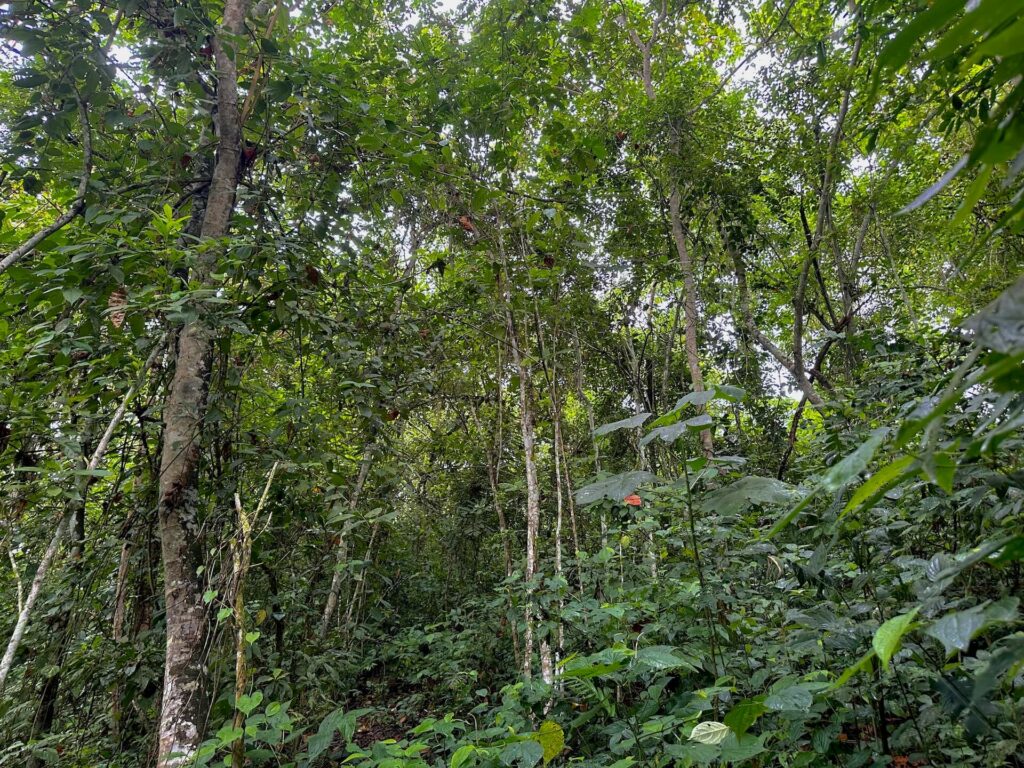
Natural forest succession doesn’t always look pretty, but there is order to this madness. (Ochoa Property approximately 9 years after it was clear-cut).
Lesson #9: Apply the principles of judo to reforestation
In judo, you use your opponent’s energy and force against them, rather than directly opposing it with your own strength. You also minimize personal effort while maximizing the effect of movements, using skill and technique over brute strength. Knowing when and where to apply force can be more important than the amount of force applied. Small, well-timed movements or shifts are often more effective than offensive strikes.
The philosophy of reforestation outlined in this article is analogous to judo, especially in the context of reforesting cattle pasture. In addition to ANR-EP, the other reforestation methodology that typifies this approach is what we call delayed planting (DP). This is the method we’re using in three of the experimental plots of the Crowther Study, which compares active tree planting vs passive natural regeneration in cattle pasture.
The “delayed planting” method is, in a sense, a hybrid of the active and passive approaches. The key is the timing.
In the “delayed planting” plots, we do absolutely nothing for the first two years. Rather than fight the elephant grass with human tools, we sit back and allow Mother Nature to do the hard work. In other words, we let the natural process of forest succession begin to unfold.
It typically takes two or three years for the first wave of native vegetation to gain a sufficient foothold in cattle pasture and begin to shade out the elephant grass. Once that phrase begins, we begin planting trees.
The delayed planting approach significantly reduces the labor spent on battling weeds, and this significantly reduces the overall restoration cost. In terms of the speed of forest recovery, the initial delay of two to three years ultimately proves to be negligible. We’re already starting to see signs that the delayed planting approach may be faster than the immediate planting approach, because natural succession is more efficient at restoring vegetation than labor-intensive human-induced weed suppression.
The seedlings that are eventually planted in the delayed planting plots also have higher survival rates than seedlings in the immediate planting plots. After a few initial years of natural restoration, the formerly dry and sun-scorched cattle pasture now has the benefit of dappled shade formed by the many volunteer trees that naturally sprout and take root.
This nascent canopy protects the soil from direct sun and also generates abundant leaf litter, which helps lower the ground temperature, preserve moisture, improve nutrient cycling, and generally provide a more fertile habitat for soil microbiota. All of these conditions are favorable to the growth of baby tree seedlings. Indeed, these are the conditions that later-successional tree species are accustomed to during the first few years of their lives.
In short, immediate tree planting has high labor costs and high mortality rates. The delayed planting method reduces labor costs and creates better conditions for the success of the seedlings that are eventually planted.
This is our judo approach to reforesting a cattle pasture. We allow the force of natural succession to overcome the pasture grass, rather than wear ourselves out with an onslaught of planting and manual weeding at the outset. The volunteer trees and pioneer species do the heavy lifting. We augment the process with well-timed planting of strategic species in subsequent years, minimizing our effort and maximizing the impact.
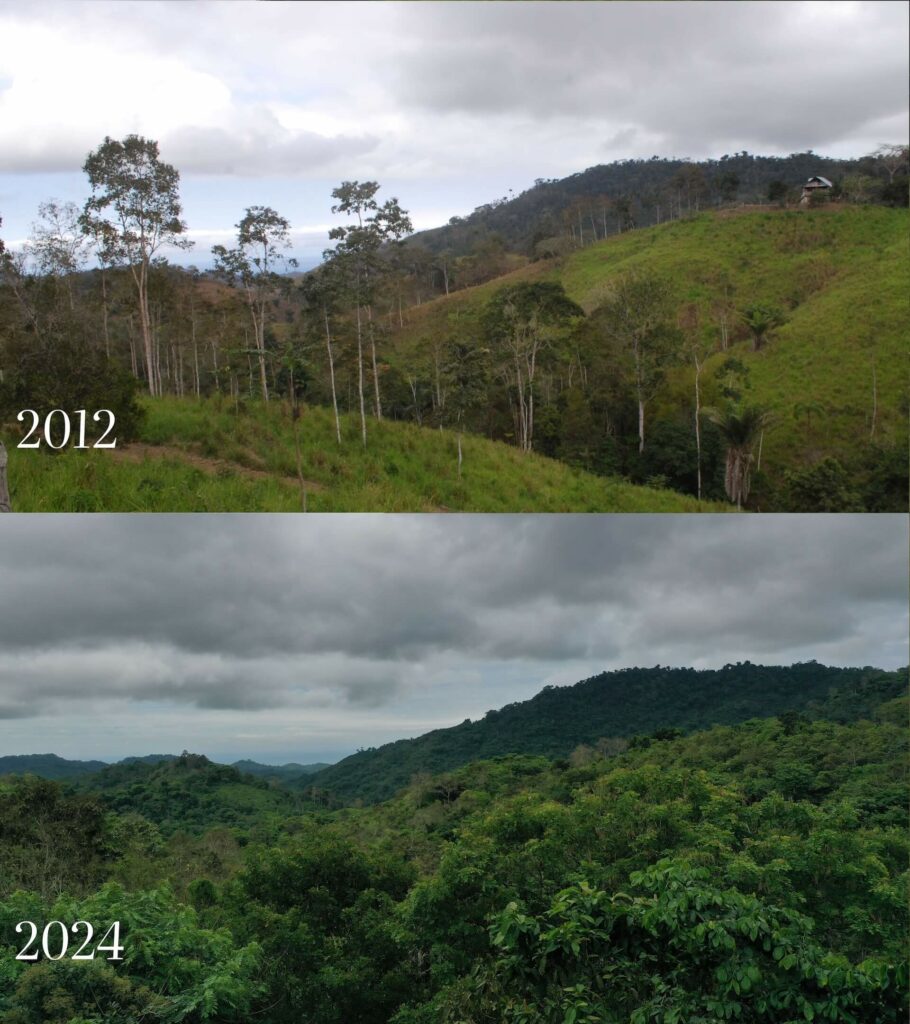
Another view of the “Finca de Madera” property (formerly 87 acres of cattle pasture).
